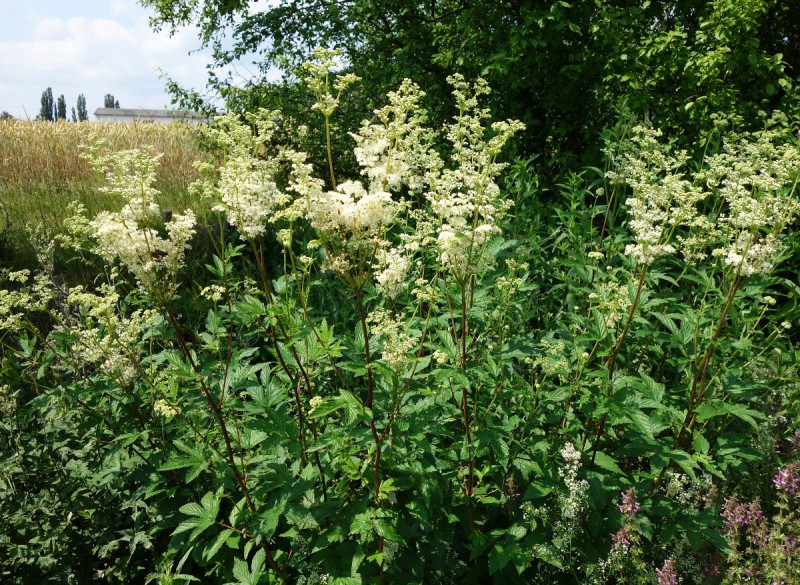Dies ist eine alte Version des Dokuments!
Filipendula ulmaria (L.) Maxim. - syn. Spirea ulmaria L., Ulmaria pentapetala Gilib. - Rosaceae
meadowsweet, queen of the meadows, Echtes Mädesüss, Große Spierstaude
Perennial herb of damp meadows, native to Europe, naturalised in North America. The creamy-white flowers emit a very strong, sweet scent.
„The whole herb possesses a pleasant taste and flavour, the green parts having a similar aromatic character to the flowers, leading to the use of the plant as a strewing herb, strewn on floors to give the rooms a pleasant aroma, and its use to flavour wine, beer, and many vinegars.“
http://en.wikipedia.org/wiki/Filipendula_ulmaria
Main components of the essential oil (0.04%) of the flowering shoot tips of F.ulmaria were salicylic aldehyde (36%), methyl salicylate (19%), linalool (2.7%), α-terpineol (1.3%), geraniol (1.4%), (E)-anethol (2.2%), and β-ionone (1.8%). Minor components were hexanal, 2-hexenal, limonene, nonanal, menthol, carvone, carvacrol, thymol, and benzaldehyde e.g.
[Valle, Maria Grazia, Gian Mario Nano, and Sergio Tira. „Das ätherische Öl aus Filipendula ulmaria.“ Planta medica 54.02 (1988): 181-182] https://www.thieme-connect.com/products/ejournals/pdf/10.1055/s-2006-962390.pdf
Prefering wet meadows and banks, the sweet floral scent with vanilla and almond-like aspects of F.ulmaria flowers dominate such places at summertime. The odor quality of hydrodistilled meadowsweet flower oil, which consists mainly of salicylic aldehyde (38.2%) and methyl salicylate (20.2%), is very different from that of the living flower. Meadowsweet oil contains about ten times the concentration of β-damascenone of rose oil, contributing significantly to its scent. The headspace of the flowers contained only 0.33% of salicylic aldehyde and no methyl salicylate at all. Main components were methyl benzoate (34.2%), cadalene (6.1%), (Z)-3-hexenyl acetate (5.5%), benzaldehyde (5.4%), camphor (1.4%), and (Z)-3-hexenol (1.2%). Important for the odor impression of meadowsweet flowers are probably benzonitril (almond-like, 0.8%), and anisaldehyde (sweet vanilla-like, 1.8%)
[Flower scent of some traditional medicinal plants., Brunke, E.J., Hammerschmidt, F.J., Schmaus, G., In ACS symposium series (USA), 1993, 282-295]
„By means of the method GC-MS is investigated a componental compound of essential oil from inflorescences Filipendula ulmaria (L.) Maхim, growing in the vicinity of Krasnoyarsk, in stages of flowering and fruiting. The basic components of essential oils in inflorescences Filipendula Ulmaria (L) Maхsim during the stages of flowering are methyl salicylate (28.2%), α-terpineol (2.1%), salicylaldehyde (2.8%), ionol (3.1%), linalool (4.9%), hotrienol (6.2%) and n-tricosane (8.3%). The basic components of essential oils in inflorescences Filipendula ulmaria (L.) Maхim during the stages of fruiting are salicylaldehyde (12.4%), ionol (11.8%) and methyl salicylate (11.2%).“
[Componental Compound of essential oil from inflorescences of Filipendula ulmaria (L.) Maxim during Stages of flowering and fruting, Zykova, I. D., and А. А. Efremov., Chemistry of plant raw material, Vol.1, 2011, 133-136] http://www.chem.asu.ru/chemwood/volume15/2011_01/1101_133.pdf
The dried flowers (Spiraeae flos) and aboveground parts (Spiraeae herb) are regarded anti-inflammatory and analgesic in folk medicine. They are used traditionally as diuretic, in supportive treatment of cold accompanied by fever, and against arthritis and rheumatism. „The volatile oil is rich in methyl salicylate and salicylaldehyde; both are present as corresponding glycosides (about 0.5%) in the intact plant (spiraein and monotropitin, resp.).“
[Medicinal Plants of the World. Ben-Erik Van Wyk and Michael Wink, Pretoria 2004, 144]
„The use of salicylate containing herbs as analgesic and antirheumatic remedies can be traced back to ancient times. While salicaceen contains only derivatives of salicylalcohol, Filipendula ulmaria is characteristic for various forms of volatile and non-volatile salicylates. The main pharmacological effect of Filipendula ulmaria is due to its salicylic acid component, which is released via oxidation from various aglycones (e.g. salicylaldehyde, methylsalicylate) developed from glycosides through hydrolysis in the digestive system.“
[Monitoring volatile and non-volatile salicylates in Filipendula ulmaria by different chromatographic techniques. Papp, Ildikó, et al. Chromatographia, Vol.68 (1), 2008, 125-129]

Masclef,A., Atlas des plantes de France, vol.2 t.99 (1890)
http://plantgenera.org/species.php?id_species=440330

Typical meadowsweet stock at a bank, CC BY-SA 3.0, Author: Andreas Kraska
